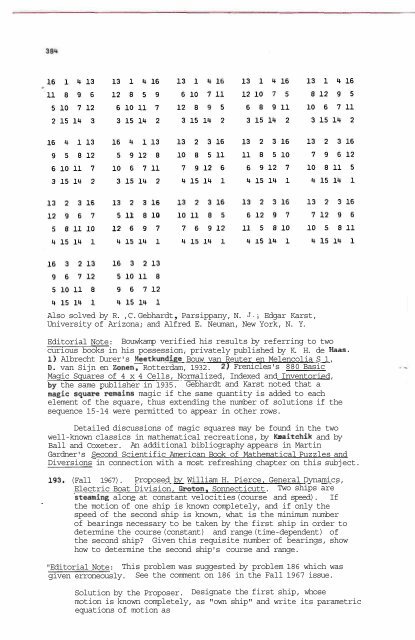Vol. 4 No 9 - Pi Mu Epsilon
Vol. 4 No 9 - Pi Mu Epsilon
Vol. 4 No 9 - Pi Mu Epsilon
You also want an ePaper? Increase the reach of your titles
YUMPU automatically turns print PDFs into web optimized ePapers that Google loves.
x = p + at cos 8y = qo + at sin 8.Similarly, designate the second ship as the "target ship" andwite its parametric equations of motion asx = x + vt cos ^Y = yo + vt sin +in which only the speed v is known. The following picture willillustrate the situation.1 x = xo + vt cos Ãy = y + vt sin Ã0I(range )B(bearing)Own ship trackspeed aAlso solved by R. ,C. Gebhardt , Parsippany, N. J. ; Edgar Karst,University of Arizona; and Alfred E. Neuman, New York, N. Y.One Bearing GivenAt time tl, bearing 0, is observed. Thus,Editorial <strong>No</strong>te: Bouwkamp verified his results by referring to twocurious books in his possession, privately published by K. H. de Haas.1) Albrecht Durer's Meetkundige Bouw van Reuter en Melencolia S 1,D. van Sijn en Zonen, Rotterdam, 1932. 2) Frenicles's 880 BasicMagic Squares of 4 x 4 Cells, <strong>No</strong>rmalized, Indexed and Inventoried,bv the same publisher in 1935. Gebhardt and Karst noted that a cos Bl = xO-pO + (v cos à - a cos 8)t 1magic squareremains magic if the same quantity is added to eachelement of the square, thus extending the number of solutions if theRlsequence 15-14 were permitted to appear in other rows.which impliesDetailed discussions of magic squares may be found in the twowell-known classics in mathematical recreations, by Knaitchik and byBall and Coxeter. An additional bibliography appears in MartinGardner's Second Scientific American Book of Mathematical Puzzles andDiversions in connection with a most refreshing chapter on this subject.(Fall 1967). Proposed by William H. <strong>Pi</strong>erce, General Dynamics,Electric Boat Division, Groton, Sonnecticutt. Two ships aresteamine - alone - at constant velocities (course and speed). Ifthe motion of one ship is known completely, and if only thespeed of the second ship is known, what is the minimum numberof bearings necessary to be taken by the first ship in order todetermine the course (constant) and range (time-dependent) ofthe second ship? Given this requisite number of bearings, showhow to determine the second ship's course and range."Editorial <strong>No</strong>te: This problem was suggested by problem 186 which wasgiven erroneously. See the comment on 186 in the Fall 1967 issue.Solution by the Proposer. Designate the first ship, whosemotion is known completely, as "own ship" and write its parametricequations of motion as(cos Bl)yo + (tcos B)v sin à - (sin B )x - (tsin B )v cos 1)1 =1 0 1(cos 6 )q + (tlcos 6,)a sin 0 - (sin Bl)p0 - (t sin Ella cos 81 0 1It should be noted that (2) does not imply (1) as there aretargets staisfying (2) which do not satisfy (l), namely targetswhose bearing differs from B by 180° Equation (2) is a linearequation in yo, v sin 1)1, x0,and v cos à whose general solution isYo = qo t A sin 0,v sin à = a sin 8Xo = Po + A cos 6,v cos à = a cos 6where A, p, and y are freerestrictionst+ ytcos B 1p sin 0 l - Y COS 0,- yt sin 61 1II cos Bl + y sin Blparameters subject only to the
















